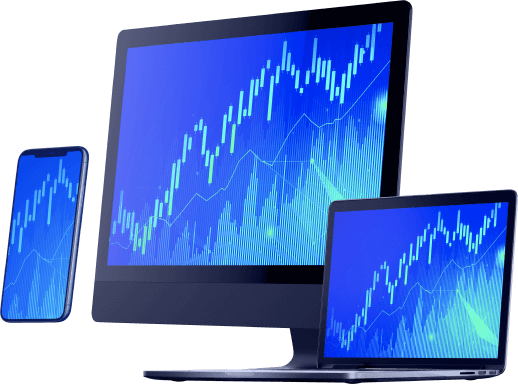Market analysis types
Both trading and investing involve the exchange of money, and there is a certain degree of risk involved. One way to try to reduce risk when investing or trading is performing ‘Fundamental’ or ‘Technical’ analysis

Course name
Start trading
Market Analysis
- Fundamental analysis involves examining the economic health or financial performance of a particular business company. A financial year is divided into four quarters, and in each quarter, business companies issue fiscal reports that show the revenues, sales, net income, debt, and other pertinent information that can help us know about the performance of the company. Investors mostly use ‘Fundamental Analysis’ to determine which company to invest in.
- Technical analysis is the process of using real-time financial data to determine future price movements.
The fundamental analysis helps us to decide which company to invest while technical analysis helps us to know when to buy or sell stocks. However, in fundamental analysis, there is a certain delay in the financial information as the monthly or quarterly reports are based on the current information. There is a time difference from the actual performance of the company to the time the reports are released. While in technical analysis, the price charts are updated in real-time.
When investing, you can also look at the potential companies according to particular sectors or industries of the market. One of the key metrics to keep an eye on is the P/E or the price to earnings ratio. To calculate the P/E ratio, the current share price is divided by the earnings per share.
Another important factor is the ‘Dividend Yield,’ which helps to determine both the performance of the company and the price of the stock. ‘Dividend Yield’ is calculated by dividing the annual dividend with the price of the stock.
Fundamental analysis is long term and thus used by investors, while technical analysis is short term and ideal for traders. Some of the important tools that help investors and traders for performing both fundamental and technical analysis are
- Economic Calendar
The economic calendar refers to certain dates in every week or month that signify particular financial events or releases that can directly impact a particular asset or the entire financial market. Both the investors and traders use the economic calendar to plan and implement a purposeful strategy. The economic calendar is available for free in our website and trading platform.
- Earnings Reports
An earnings report is a quarterly financial report that is posted or released by a publicly-traded company that highlights the performance of the company in that particular quarter. The earnings reports show the earnings per share (EPS), net income, net sales, and debt. Investors can use the earnings report to see the financial health of the company and whether the company would be a good investment or not. You can find the earning report information in our education center.
- Historical Charts
One of the most fundamental tools for trading is the evaluation of a price chart that shows the historical and current market information. The historical price action is a key component of technical analysis as it helps traders to determine the future price movements. The historical chart shows valuable market data that includes the price, volume, and volatility for a defined period of time
- Central Bank Announcement
The Central Bank Announcement reveals the monetary policy and economic outlook of a country. The key highlights of the announcement are the interest rate, currency rate, and inflation.
- Market Sentiment
The overall attitude of the investors towards a particular stock or financial market is known as
‘Market Sentiment’ and determined by the market trends and price movements. Market sentiment is
considered ‘Bullish’ when the price of the stock or any other financial instrument is rising and
considered ‘Bearish’ when the price is falling.
The Significance of Market Analysis
The financial market analysis is a process of determining the performance of a particular financial market. The performance of the financial market depends on the total number of assets that are traded in a market on a given day; if the trade closes with prices of most assets on the higher side than it is said that the market performed well. For example, the performance of a Stock Market is reflected by an indicator called ‘Index,’ which tracks the efficiency of some of the popular shares that are traded.
The market economy is on the rise, and many of the businesses and markets are integrating, which increases the importance of the financial market index. Traders are not banking on investing in just Stock or Forex markets but expanding their portfolio by trading in the Commodity and Cryptocurrency market as well.
The need for financial market analysis has become important with the integration of markets on a wider scale. The financial analysis takes into account factors and activities both inside and outside the market. Financial analysis is a specialized activity that requires the knowledge and experience of financial analysts and economists who are trained to use numerous tools to measure the performance of a market.
The modern-day analysis is made fast and easy with the help of digital software and innovative systems that allow analysis to study the market from every angle and perspective. The integration of technology has helped to solve even complex aspects of financial analysis. The analysts study the internal and external factors that directly or indirectly influence the behavior of a particular market. The analysts divide the financial markets by the type of assets that are traded. Some of the common types of analysis of financial markets include Fundamental Analysis, Technical Analysis, Market Analysis, Securities Market Analysis, and Index Momentum Analysis
- Fundamental Analysis
The process of fundamental analysis is done to evaluate the intrinsic value of an asset or security by assessing several financial and economic factors. The fundamental analysts study every major and minor factor that can influence the value of the security, which includes asset management, interest rate, and revenue. The main emphasis of the analysis is to provide the investor with a comparison of the security’s current price to see if the security is overvalued or undervalued.
Fundamental analysis is mostly used for determining the real value of stocks, but it can easily be used for other types of security as well, such as a bond or a derivative instrument. The analysts also study both tangible assets (company building, land, machinery, and equipment) and intangible assets (branding, trademarks, and patents) while making their findings.
- Fundamental vs. Technical Analysis
Fundamental analysis is a method that is done to examine the performance of a company and determine its stock’s intrinsic value. There are several factors that are studied to draw a comparison with the stock market price and fair market value. The ‘Buy’ and ‘Sell’ decisions are taken knowing if the stock is trading undervalue or overvalue.
Technical analysis is the statistical evaluation that uses data such as price changes, volume, and returns to make patterns that can be used to predict future price movements. While the fundamental analysis is done to calculate the intrinsic value of a security, the technical analysis is done to estimate the future activity of the security and market as a whole.
| Fundamental Analysis | Technical Analysis |
|---|---|
|
|
Fundamental analysis is a common tool used by investors all over the world to evaluate the financial statements of a business company that includes ‘Balance Sheets, Income Statements, and Cash Flow Statements.’
A balance sheet compares the company’s current assets against liabilities and owner’s equity. Assets are defined as the items or things that the company owns, such as equipment, property, and cash. Liabilities are the debt or accounts that need to be paid. The owner’s equity or capital is defined as the amount of assets the company raises by issuing stock.
An income statement shows how a company earns or generates money. The two main aspects of income statements are ‘Revenues’ and ‘Expenses.’ The expenses show the cost of running the business and include operations, interest paid on loans, and taxes. When expenses are subtracted from revenues, the company gets ‘net income,’ which is the earnings of the company. The earnings of the company are shared in two ways: first is to share the earnings with shareholders by paying a dividend. The second is to reinvest the earnings back into the company, which helps the company become more stable during economic downturns.
The cash flow statement shows how a company uses its cash to operate the business and make investments. The statement also shows how much debt is borrowed from the bank or bondholder. The operations, investments, and debt are added to see the changes in the overall cash position of the company.
Analysis of all the statements can be challenging, which is why most investors take help from ratios
and analyze the financial information more accurately. The ratios help to determine the valuation,
financial strength, and profitability of a business company.



